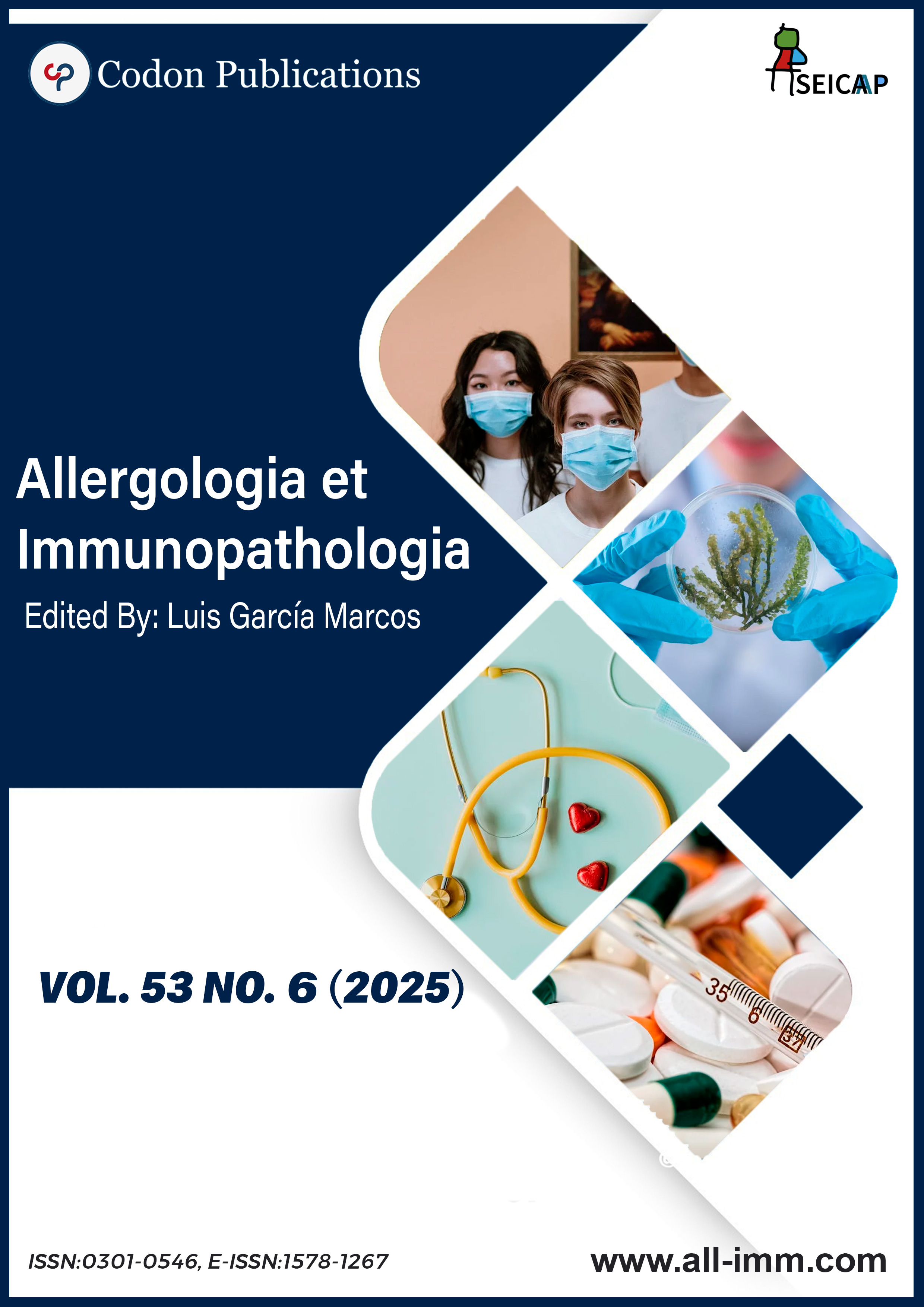Prevalence and triggers of allergic diseases across different age groups: A comparative analysis of patients aged under 50, 50–64, and 65 and older
Main Article Content
Keywords
allergy, age, elder, prevalence, trigger
Abstract
Allergic diseases are prevalent immune disorders that have a considerable impact on public health. Although these cases are traditionally linked with younger individuals, older populations are increasingly affected due to immunological changes and a greater prevalence of comorbidities. The aim of this study was to evaluate the prevalence and triggers of allergic diseases across three age groups—under 50, 50–64, and 65 and older—to inform age-specific prevention and treatment strategies. In this retrospective study, data from 352 patients (270 females and 82 males) who presented to our allergy clinic between December 2022 and December 2023 were analyzed. Patients were grouped by age and data on allergic diseases, triggers, comorbidities, and skin prick test results were evaluated. Appropriate statistical analyses were performed, with statistical significance defined as p < 0.05. Allergic rhinitis (39.8%) was the most prevalent allergic disease, followed by chronic spontaneous urticaria (28.1%), and acute urticaria-angioedema (27.8%). Drug allergies were significantly more frequent in older adults (p = 0.016), with nonsteroidal anti-inflammatory drugs and beta-lactam antibiotics being common triggers. Allergic rhinitis was more prevalent in the < 50 age group (p = 0.013). Skin prick tests revealed sensitivities to pollen (9.4%), house dust mites (8.8%), and cat allergens (2.8%). Allergic diseases vary in frequency across age groups. Allergic rhinitis is more common in younger patients, while drug allergies are dominant in the elderly, likely due to polypharmacy. Raising awareness and tailoring diagnostic approaches for allergic diseases in older adults is essential. Further multicenter studies are needed to confirm these findings.
References
2 Nam JS, Hwang CS, Hong MP, Kim KS. Prevalence and clinical characteristics of allergic rhinitis in the elderly Korean population. Eur Arch Otorhinolaryngol. 2020;277(12):3367–73. 10.1007/s00405-020-06256-5
3 Spiteri K, Broom D, Bekhet AH, de Caro JX, Laventure B, Grafton K. Barriers and motivators of physical activity participation in middle-aged and older-adults–A systematic review. J Aging Phys Act. 2019;27(4):929–44. 10.1123/japa.2018-0343
4 Cardona V, Guilarte M, Luengo O, Labrador-Horrillo M, Sala-Cunill A, Garriga T. Allergic diseases in the elderly. Clin Transl Allergy. 2011;1:11.
5 Yildiz E, Çölkesen F, Arslan Ş, Evcen R, Sadi Aykan F, Kilinç M, et al. Allergic diseases in the elderly population: A single-center experience. Turk J Med Sci. 2021;51(5):2631–40. 10.3906/sag-2104-55
6 Genuneit J, Standl M. Epidemiology of allergy: Natural course and risk factors of allergic diseases. In: Traidl-Hoffmann C, Zuberbier T, Werfel T, editors. Allergic Diseases – From Basic Mechanisms to Comprehensive Management and Prevention [Internet]. Cham: Springer International Publishing; 2022. pp. 21–7. Available from: 10.1007/164_2021_507
7 Sánchez-Borges M, Ansotegui IJ, Baiardini I, Bernstein J, Canonica GW, Ebisawa M, et al. The challenges of chronic urticaria part 1: Epidemiology, immunopathogenesis, comorbidities, quality of life, and management. World Allergy Organ J. 2021;14(6):100533. 10.1016/j.waojou.2021.100533
8 Zuberbier T, Maurer M. Urticaria: Current opinions about etiology, diagnosis and therapy. Acta Derm Venereol. 2007;87(3):196–205. 10.2340/00015555-0240
9 Wilkerson RG. Drug hypersensitivity reactions. Immunol Allergy Clin North Am. 2023;43(3):473–89. 10.1016/j.iac.2022.10.005
10 Patterson RA, Stankewicz HA. Penicillin allergy. In: StatPearls [Internet]. Treasure Island (FL): StatPearls Publishing; 2024. Available from: http://www.ncbi.nlm.nih.gov/books/NBK459320/
11 Maurer M, Zuberbier T, Metz M. The classification, pathogenesis, diagnostic workup, and management of urticaria: An update. In: Traidl-Hoffmann C, Zuberbier T, Werfel T, editors. Allergic Diseases – From Basic Mechanisms to Comprehensive Management and Prevention [Internet]. Cham: Springer International Publishing; 2022. pp. 117–33. Available from: 10.1007/164_2021_506
12 Bigby M. Rates of cutaneous reactions to drugs. Arch Dermatol. 2001;137(6):765–70.
13 Zalewska-Janowska A, Spiewak R, Kowalski ML. Cutaneous manifestation of drug allergy and hypersensitivity. Immunol Allergy Clin North Am. 2017;37(1):165–81. 10.1016/j.iac.2016.08.006
14 Siddiqui ZA, Walker A, Pirwani MM, Tahiri M, Syed I. Allergic rhinitis: Diagnosis and management. Br J Hosp Med Lond Engl 2005. 2022;83(2):1–9. 10.12968/hmed.2021.0570
15 Ediger D, Günaydin FE, Erbay M, Şeker Ü. Trends of sensitization to aeroallergens in patients with allergic rhinitis and asthma in the city of Bursa, South Marmara Sea Region of Turkey. Turk J Med Sci. 2020;50(2):330–6. 10.3906/sag-1908-139
16 Sabroe RA. Acute urticaria. Immunol Allergy Clin North Am. 2014;34(1):11–21. 10.1016/j.iac.2013.07.010
17 Antia C, Baquerizo K, Korman A, Bernstein JA, Alikhan A. Urticaria: A comprehensive review: Epidemiology, diagnosis, and work-up. J Am Acad Dermatol. 2018;79(4):599–614. 10.1016/j.jaad.2018.01.020
18 Chiang V, Kan AKC, Saha C, Au EYL, Li PH. Identifying the most at-risk age-group and longitudinal trends of drug allergy labeling amongst 7.3 million individuals in Hong Kong. BMC Med. 2024;22(1):30. 10.1186/s12916-024-03250-0

